Second in a Series:
Driving on a Greek island is easy — if you let your spouse take the wheel.
I’m fortunate, in a way, that my wife, Catharine, gets a bit nauseous if she tries to read anything — such as a map — in a moving car. That means that in unfamiliar territory without a GPS, I get to navigate, and she has to drive.
Getting to our house on Milos — which we had rented for a week’s vacation with our son, daughter-in-law and six-month-old grandson — was something of an adventure.
Driving up from Adamas, the largest town in Milos and site of the ferry terminal and waterfront marina, required following a winding road up through the hills while cars zipped around us, passing on blind curves. Catharine stuck to the speed limit, which, come to think of it, wasn’t posted.
Eventually we reached an intersection marked by an old-time, open-air cafe where men flipped worry beads and passed the time sipping strong, unfiltered Greek coffee out of little cups. They appeared to be in no hurry at all.
A left turn there took us higher up into the hills to the town of Tripiti, where almost all the houses are whitewashed in the typical manner of the Cyclades and all the streets are narrow and either rutted or cobbled. And oh yes, unmarked. Or occasionally marked in Greek, which is equally helpful.
That was where I got to do my best supercilious GPS imitation. “Go past the stone house on the left and take the sharp right turn straight up the hill,” I instructed. “Be sure to keep it in first gear. Then take a hard left at the green garbage bin.”
After throwing me a dubious glare, Catharine gunned our rented blue Fiat Panda to the right up an impossibly steep hill without stalling out, a testimony to our years driving stick shift cars up the streets of San Francisco.
The left at the garbage bin then led us down our particularly narrow street, where, toward the end, loomed what we came to label the “Drive-thru of Dents.”
On one side protruded the concrete foundation of an old house, while on the other a railing in front of the neighbor’s ground-floor patio further pinched the street. These were unmovable objects, unlike the stray cats who liked to curl up in the middle of the road and reluctantly scattered as we neared.
At the other end of the Drive-thru of Dents lay a prized private parking spot, essential for loading and unloading all our gear each time we went out, including a baby stroller, sizable diaper bag, and other accouterments that we hadn’t traveled with for decades. (I’ll have more on traveling with a baby in a future post.)
The only way we could maneuver the Panda through the dent factory was to fold the outside rear view mirror in on whichever side was up against the patio railing, which was more than capable of crunching the mirror into little pieces. Once the mirror was folded in, it took careful steering and nerves of steel to avoid scraping the car; clearance on either side was just a matter of inches or less.
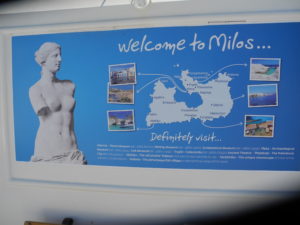
Sign at the harbor welcoming visitors to the island where the Venus de Milo was found. Photo by Clark Norton
While the Drive-thru of Dents lived up to its name the first few tries — Milos is crawling with scratched rented blue Fiat Pandas — Catharine eventually became quite expert at the maneuver and, once through, we were home free to enjoy our parking place, as long as we missed the tree, motorcycle, and more stray cats that often shared the space.
The whole process also entertained various local residents, who seemed to enjoy chuckling at our ordeal. But by the end of the week, they clearly looked forward to our comings and goings and gave us a wink and a nod each time we successfully negotiated the obstacle course.
Early Morning Explorations
Our daily routine in Milos was quite different from back in the U.S.
Even though Catharine and I still rose very early — we liked to watch the sunrise from our terrace while drinking our coffee and listening to the sounds of roosters, goats, dogs, and doves reverberate through the valley below — we followed the Greek practice of midday languor, indulging in big lunches that sometimes lasted until 4 p.m., preceded or followed by a nap.
Baby Conrad — and therefore his patient parents, Grael and Nona — was on his own late-sleeping schedule, so we two grandparents went off on our own most mornings until we gathered with the younger generations for lunch. We wanted to do much of our walking and sightseeing before the sun acquired its mid-morning scorch.
One morning we hiked uphill to Plaka, the next village along the road from where we were staying in Tripiti. Plaka occupies one of the highest spots on our end of the island, and is Milos’ oldest settlement and current capital. It’s also the very picture of a classic Greek village, with a tangle of winding cobbled streets snaking up this way and that, a number of pleasant squares, and plenty of shops and inviting outdoor tavernas.
Eventually we followed signs to the “Kastro,” which led us up dozens of stone steps to an old fortress at the summit, where we were rewarded with 360-degree views of the island and the Aegean Sea.
On another morning early in the week, Grael accompanied us on a walk from Tripiti to nearby ancient Christian catacombs — tombs dating back to the early centuries AD.
After a short tour of the catacombs — not for the claustrophobic — we followed a trail from there to a well preserved Roman amphitheater that sits high above the harbor and is now used for public performances with stunning views of the water and hills beyond.
En route, we came upon a sign marking the spot where a farmer in 1820 found what is now one of the world’s most renowned sculptures, the Venus de Milo (“de Milo” indicating “of Milos”), which has become perhaps the island’s greatest claim to fame. (There are no dearth of plastic versions in the souvenir shops.)
The story of how Venus — which should actually be called “Aphrodite” after the Greek version of the Roman goddess Venus — lost her arms is a bit murky. One common theory is that they were broken off during a tussle with the French, who bought or expropriated the statue that now draws countless visitors to the Louvre in Paris. But they may have been lost in transport or in various other ways.
Ironically, her missing arms — and the mystique that surrounds them — has no doubt added immensely to her fame. Once attributed to the master Praxiteles, she is now believed to have been the work of the otherwise obscure Alexandros of Antioch ,and may even be a copy of a yet older sculpture.
We topped off that morning with breakfast at a cafe in Tripiti with million-dollar views and 10-euro feasts that included two eggs, bacon, fresh bread with honey and jam, a generous serving of the best yogurt any of us had ever eaten, coffee (filtered or unfiltered), and fresh orange juice that rivaled the yogurt for best-ever status.
Where had Milos been all our lives? And we had barely begun to explore it all.
Coming Up: Long lunches, very late dinners, and Milos’ remarkable array of beaches and landscapes.
Earlier in This Series: Milos, Greek Isle Steeped in Beauty, History
.

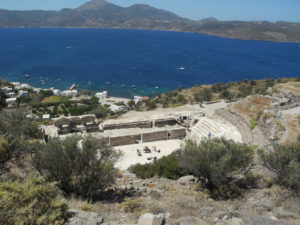
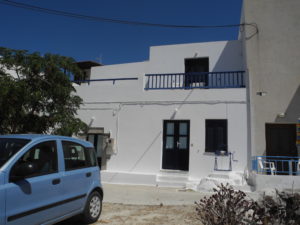
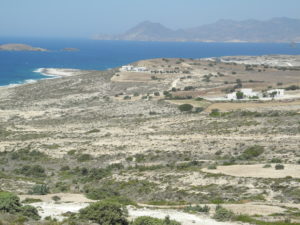
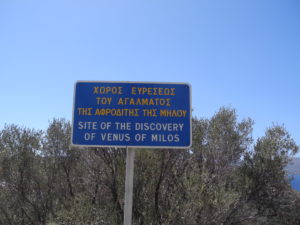











Leave a Reply